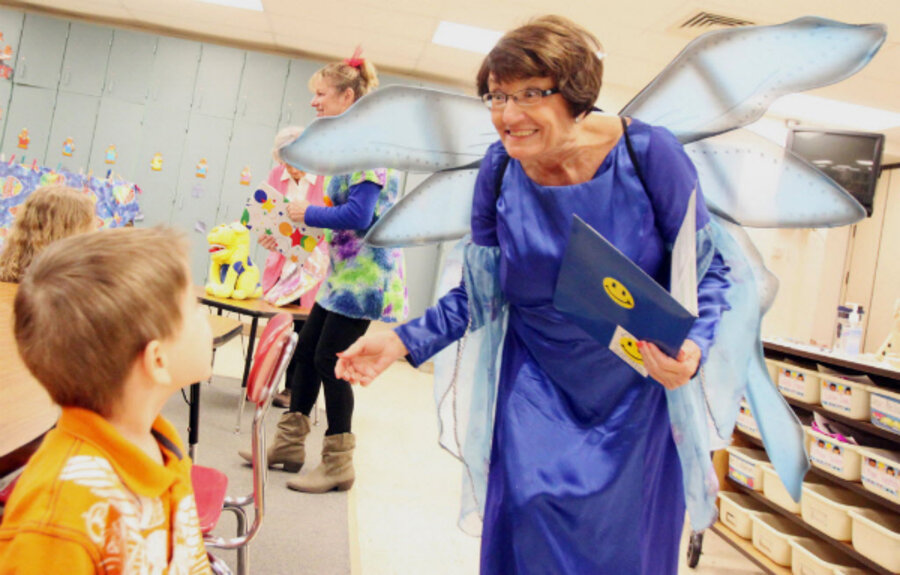Tooth fairy: Toy industry wants to monetize the "holiday moment"
Loading...
For children, losing one’s baby teeth is an important rite of passage. It marks a child’s departure from early childhood and entry into middle childhood – a time when, among other milestones, a child’s belief in magic begins to recede.
Because of this, there’s something precious about the myth of the tooth fairy. Our children’s belief that the tooth fairy is real is a sign that they are still little, that they’re not growing up too quickly, that they’re still innocent. Children love the strange idea that a tooth will be whisked away in the night by a fairy, with money or a small token left in exchange: It’s a fun, harmless fantasy.
Unlike the holidays of Christmas and Easter, which also have their own beloved fantasy figures attached to them, there is no predicting when an individual tooth will fall out. Waiting for a loose tooth to wiggle its way out takes patience – and once it’s out, it can be nerve-wracking for a child to keep it safe until the tooth fairy can collect it.
Perhaps because losing a tooth is such a personal, individual event, it has not been commercialized in the way that collective holidays and their fantasy figures have been. In the U.S., for example, millions of Christian families spend months gearing up for Christmas, anticipating the joy and the gifts it will bring. Marketers do everything they can to encourage people to spend a lot on the holidays; sales and specials encouraging purchases seem to begin earlier every year, and a fairly uniform image of Santa Claus is widely used in these promotions.
But with children’s teeth on their own individual timetables, marketers have never tried to monetize this milestone… Until now.
Susan Linn of the Campaign for a Commercial-Free Childhood reports that The Real Tooth Fairies, LLC is working hard to colonize the tooth fairy myth. Founded in 2011 by seasoned toy industry executives, The Real Tooth Fairies takes the open-ended, family-centered tooth fairy tradition and subjects it to a heavy-handed marketing makeover.
The way its marketing team sees it, “Each tooth is really a holiday moment” – in the same way that Christmas, Easter, Valentine’s Day, and Halloween are holiday moments: moments that can be commercialized, packaged, and sold to consumers. In fact, they explain, “It’s just a massive opportunity.”
In the world of the Real Tooth Fairies, there is not just one tooth fairy; there are six tooth fairies who have been coronated by a tooth fairy queen. Why six? The brand is copying the formula for success experienced by other popular girls’ brands, such as Disney Princess, the Disney Fairies, Bratz Dolls, and the Spice Girls. Like the characters from those marketing success stories, each fairy has a different look: their hair color and skin tones vary – but not their body types; they all fit the Barbie mold. They also have different interests, ranging from animals to math to rock music – though without fail, each one of them has a handsome boyfriend. And a tiara.
In addition to these seven characters, the brand also serves up a short, stout, eyeglass-wearing, hairy-legged “wannabe” tooth fairy called “Stepella” who, like Cinderella’s ugly stepsisters, is clearly meant as a counterpoint to the tall, pretty, real fairies. Unfortunately, her existence perpetuates a negative stereotype that (like so much about this brand) is not age appropriate, and which our girls don’t need: She suggests that any girl who doesn’t achieve a stereotypically beautiful appearance is unworthy of love and acceptance – unwanted. Although the brand claims to promote kindness, Stepella is excluded from the group.
Real girls, called “Earthies” on the Real Fairies site, are expected to identify with one specific “real fairy” from the main group of six, and then make requests on the web site for things that their parents will have to pay for – everything from personalized letters from a favorite fairy (starting at $0.99) to birthday party packages (costing $379).
So much for the tooth fairy myth’s innocent simplicity.
In fact, the brand grafts together components from nearly every popular girls’ brand: fashion (Barbie and Bratz), music (Hannah Montana), fairies (Tinkerbell and friends), royalty and romance (Disney Princesses), a pro-social “kindness” message (Monster High), and so on. It’s a transparent effort to push every button possible in hopes the brand would sell.
Susan Linn agrees with this assessment. ”It’s like an amalgam of the worst trends in the toy industry,” she said. “It contains every known money-making ploy in a pseudo-sweet ambiance, but it’s full of gender stereotyping and sexualization.”
Although the brand was launched in December 2011, it has recently grown dramatically in popularity: In April 2013, it boasted 7.1 million unique viewers. It has already been funded with $3.9 million. With these promising viewing trends, the owners want to raise an additional $4 million to expand it; they’re seeking to add a boys’ section to the site (with time-traveling action-adventure elves, because apparently fairies are too “girly” for boys) and get licensed products into stores – so they created a pitch video for potential investors.
The company’s pitch video recently came to the attention of CCFC. Upon seeing it Linn, was disgusted. “The pitch to investors epitomizes the worst of the toy industry,” Linn said. “They’re cloaking themselves as doing something good for children, when really it’s about making money.”
While corporations often feign that their product is meant to do something good for children – e.g., Monster High’s claim that it teaches kindness, which The Real Tooth Fairies, LLC has also copied – there’s something particularly problematic about the way it is playing out here. Linn points out that the tooth fairy has always been in the public domain, and beliefs about the tooth fairy have been very diverse. Families have enjoyed devising their own tooth fairy rituals for generations – and, Linn fears, The Real Tooth Fairy, LLC hopes to put an end to that.
“This is a major assault on an area of childhood that has been unbranded,” Linn explained. “It’s an assault on the imagination. Families have always made up their own tooth fairy rituals, and it’s egregious to stultify children’s imaginations in that way.”
To help CCFC save the tooth fairy, visit their web page or sign their petition.
Follow Rebecca Hains on Twitter or Facebook. The Christian Science Monitor has assembled a diverse group of the best family and parenting bloggers out there. Our contributing and guest bloggers are not employed or directed by the Monitor, and the views expressed are the bloggers' own, as is responsibility for the content of their blogs. Rebecca Hains blogs at rebeccahains.wordpress.com.








